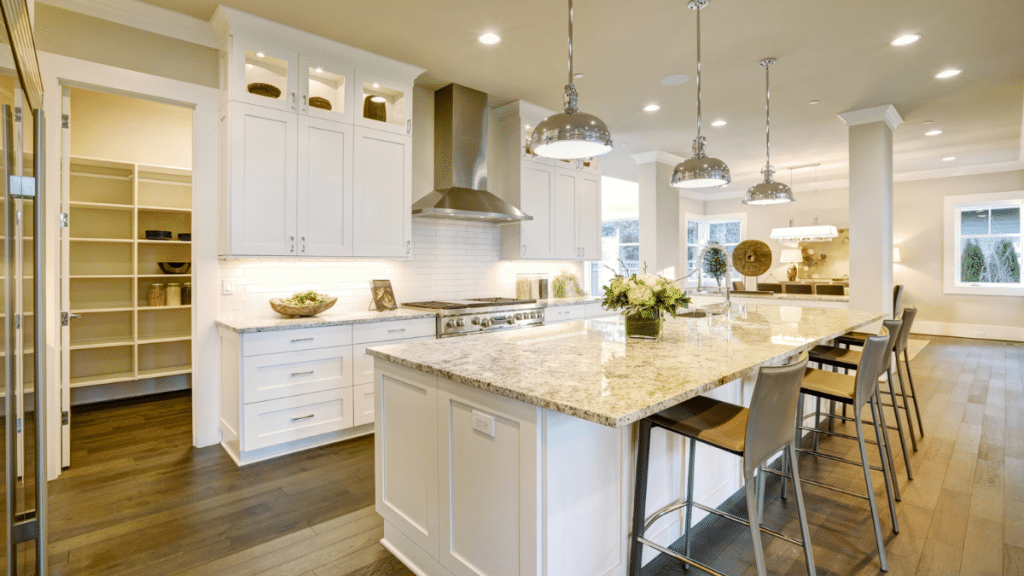When planning a kitchen upgrade, one of the most defining decisions you’ll face is whether to opt for open shelving, closed cabinets, or a mix of both. This design choice doesn’t just affect the overall look of your kitchen—it also plays a key role in how your space functions daily. To help you make an informed decision, we’ve broken down the pros and cons of each, and how they align with different lifestyles, aesthetics, and storage needs.
Whether you’re a minimalist, a maximalist, or somewhere in between, working with custom kitchen renovation specialists in Perth can help ensure your storage choices complement your vision while making the most of your space.
The Case for Open Shelving
Open shelving has become a hallmark of contemporary and Scandi-inspired kitchen designs – it offers a sense of airiness and accessibility that many homeowners love.
Pros
- Visually Light and Spacious: Open shelves create an illusion of more space, making them ideal for smaller kitchens or open-plan living.
- Easy Access: Everyday items like plates, glasses, and spices are within arm’s reach, which is both practical and time-saving.
- Design Statement: Styling shelves with ceramics, plants, and cookbooks allows you to showcase personality and elevate your kitchen’s aesthetic.
Cons
- Requires Organisation: Open shelving demands neatness. If you prefer to tuck clutter out of sight, this may be a challenge.
- Dust and Grease Buildup: Without cabinet doors, items on open shelves can gather dust or cooking residue more quickly.
The Benefits of Closed Cabinets
Closed cabinetry has long been the default in kitchen design—and for good reason. It offers structure, uniformity, and excellent concealment for everything from pantry staples to unsightly appliances.
Pros
- Clutter-Free Appearance: Closed doors keep everything out of sight, making your kitchen feel cleaner and more streamlined.
- Better Protection: Items stored behind doors are less exposed to dust, moisture, and heat—ideal for food and delicate items.
- Design Flexibility: Cabinets come in a vast range of colours, finishes, and door styles to suit any kitchen theme.
Cons
- Visually Heavier: In smaller kitchens, banks of overhead cabinets can make the space feel boxed in or darker.
- Accessibility: Items can be harder to see and reach, especially in deep cupboards or corner units.
The Hybrid Approach: Best of Both Worlds
If you’re torn between form and function, a hybrid layout may be the perfect solution. Many homeowners choose open shelving for upper storage (ideal for décor or frequently used items), paired with closed cabinets below to hide less attractive essentials. This approach offers balance—keeping your kitchen practical while still injecting warmth and personality.
Which Style Suits You Best?
Here are a few guiding questions to help you decide:
- Are you tidy by nature, or do you prefer to hide the mess?
- Do you want to display décor or stick to pure function?
- Is your kitchen compact and in need of visual lightness, or spacious enough to handle the weight of closed cabinetry?
- Do you entertain often and want to impress with a styled setup, or prioritise ease of use and cleanliness?
Choosing between open shelving and closed cabinets isn’t just a matter of style—it’s about how you use your kitchen every day
The right balance will vary based on your lifestyle, your cleaning habits, and the atmosphere you want to create in your home. Also, working with custom kitchen renovation specialists can help tailor a solution that strikes the ideal balance between aesthetics and usability, ensuring your kitchen is both beautiful and built for everyday living. Whether you lean minimalist or traditional, your kitchen storage should support your vision, not limit it.
